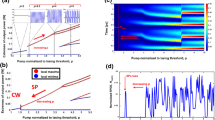Abstract
It has been suggested (by Pessina et al. in 1997) that the observed spontaneous mode beating of erbium-doped-fiber ring lasers can be explained as the multimode instability described in 1968 by Risken and Nummedal and by Graham and Haken (the RNGH instability), which is based on Rabi-splitting-induced gain. If true, this would constitute the first ever example of this instability in an actual experiment. We test the hypothesis through a quantitative experimental investigation. We demonstrate that there is indeed a clear, marked onset of the instability, a fact that went unnoticed in all previous experiments because it is very close to the lasing threshold. We intentionally raise cavity loss to better separate onset of lasing and of instability. We obtain quantitative information on the instability onset. An interpretation as the predicted second threshold is reasonable provided inhomogeneous gain line broadening is taken into account. We also observe that instability above its onset exists only intermittently; this may hint at a subcritical bifurcation and noise-driven transitions. In any event, the RNGH mechanism is present, if not in a pure form.
Similar content being viewed by others
References
C.O. Weiss, R. Vilaseca: Dynamics of Lasers (VCH, Weinheim 1991)
Ya.I. Khanin: Principles of Laser Dynamics (Elsevier, Amsterdam 1995)
P. Mandel: Theoretical Problems in Cavity Nonlinear Optics (Cambridge University Press, Cambridge 1997)
O. Svelto: Principles of Lasers (Plenum, New York 1989)
H. Risken, K. Nummedal: Phys. Lett. A 26, 275 (1968)
H. Risken, K. Nummedal: J. Appl. Phys. 39, 4662 (1968)
R. Graham, H. Haken: Z. Phys. 213, 420 (1968)
F. Fontana, M. Begotti, E.M. Pessina, L.A. Lugiato: Opt. Commun. 114, 89 (1995)
E.M. Pessina, G. Bonfrate, F. Fontana, L.A. Lugiato: Phys. Rev. A 56, 4086 (1997)
Q.L. Williams, J. Garcia-Ojalvo, R. Roy: Phys. Rev. A 55, 2376 (1997)
E. Roldán, G.J. de Valcárcel: Europhys. Lett. 43, 255 (1998)
E.M. Pessina, F. Prati, J. Redondo, E. Roldán, G.J. de Valcárcel: Phys. Rev. A 60, 2517 (1999)
T.-M. Voigt, M.O. Lenz, F. Mitschke: Proc. SPIE 4429, 112 (2000)
L.A. Lugiato, L.M. Narducci, E.V. Eschenazi, D.K. Bandy, N.B. Abraham: Phys. Rev. A 32, 1563 (1985)
G.J. de Valcárcel, E. Roldán, F. Prati: Opt. Commun. 163, 5 (1999)
E. Roldán, G.J. de Valcárcel, F. Mitschke: Appl. Phys. B 76, 741 (2003)
P. Franco, M. Midrio, A. Tozzato, M. Romagnoli, F. Fontana: J. Opt. Soc. Am. B 11, 1090 (1994)
K. Tamura, H.A. Haus, E.P. Ippen: Electron. Lett. 28, 2226 (1992)
F. Fontana, E. Pessina: private communication
G.P. Agrawal: Nonlinear Fiber Optics (Academic, San Diego 1995)
E. Roldan, G.J. de Valcárcel, F. Silva, F. Prati: J. Opt. Soc. Am. B 18, 1601 (2001)
F. Prati, E.M. Pessina, E. Roldán, G.J. de Valcárcel: Opt. Commun., in print
E. Roldán, G.J. de Valcárcel: Phys. Rev. A 64, 053805 (2001)
Equations (14) and (30) in [23] can be applied to three-level lasers by substituting α in (30) by α/(1+W)1/2 and by taking into account that r in (14) relates to W through (16) in [23]. This does not take into account distributed losses. In order to take them into account, the relation between r and W is not that of (16) in [23] but W=[G0+(1+u)(γd+|lnR|)r]/[G0-(1+u)(γd+|lnR|)r], where u=γinh/γ⊥ is the inhomogeneous to homogeneous broadening ratio. The lasing threshold occurs at r=1. Notice that the symbol r entering the above equation does not have the same meaning as the one used in the present article: in [23], and in the above equation, r represents the normalized pump in a two-level laser
J.F. Urchueguia, G.J. de Valcárcel, E. Roldán, F. Prati: Phys. Rev. A 62, 041801(R) (2000)
M.J. Guy, J.R. Taylor, R. Kashyap: Electron. Lett. 31, 1924 (1995)
J.L. Zhang, C.Y. Yue, G.W. Schinn, W.R.L. Clements, J.W.Y. Lit: IEEE J. Lightwave Technol. 14, 104 (1996)
D.I. Chang, M.J. Guy, S.V. Chernikov, J.R. Taylor, H.J. Kong: Electron. Lett. 32, 1786 (1996)
H. Fu: Phys. Rev. A 40, 1868 (1989)
T.W. Carr, Th. Erneux: Phys. Rev. A 50, 724 (1994); Phys. Rev. A 50, 4219 (1994)
The reader may wonder why we have not tried to test this hypothesis by numerical integration of the model in [23]. As discussed elsewhere [22, 33], the numerical integration for class B lasers is extremely difficult because of the enormous stiffness of the problem. In fact, the first numerical integrations of the Maxwell–Bloch equations with inhomogeneous broadening in the uniform-field limit have been carried out only very recently [22], and much work needs to be done in this direction. In any case, there is numerical evidence that, with inhomogeneous broadening, the RNGHI can also be subcritical (F. Prati, Universitá dell’Insubria, private communication)
A. Amon, M. Nizette, M. Lefranc, T. Erneux: Phys. Rev. A 68, 023801 (2003)
G.J. de Valcárcel, E. Roldán, F. Prati: J. Opt. Soc. Am. B 20, 825 (2003)
Author information
Authors and Affiliations
Corresponding author
Additional information
PACS
42.65.Sf; 42.60.Mi; 42.55.Wd
Rights and permissions
About this article
Cite this article
Voigt, T., Lenz, M., Mitschke, F. et al. Experimental investigation of Risken–Nummedal–Graham–Haken laser instability in fiber ring lasers. Appl Phys B 79, 175–183 (2004). https://doi.org/10.1007/s00340-004-1531-5
Received:
Published:
Issue Date:
DOI: https://doi.org/10.1007/s00340-004-1531-5




